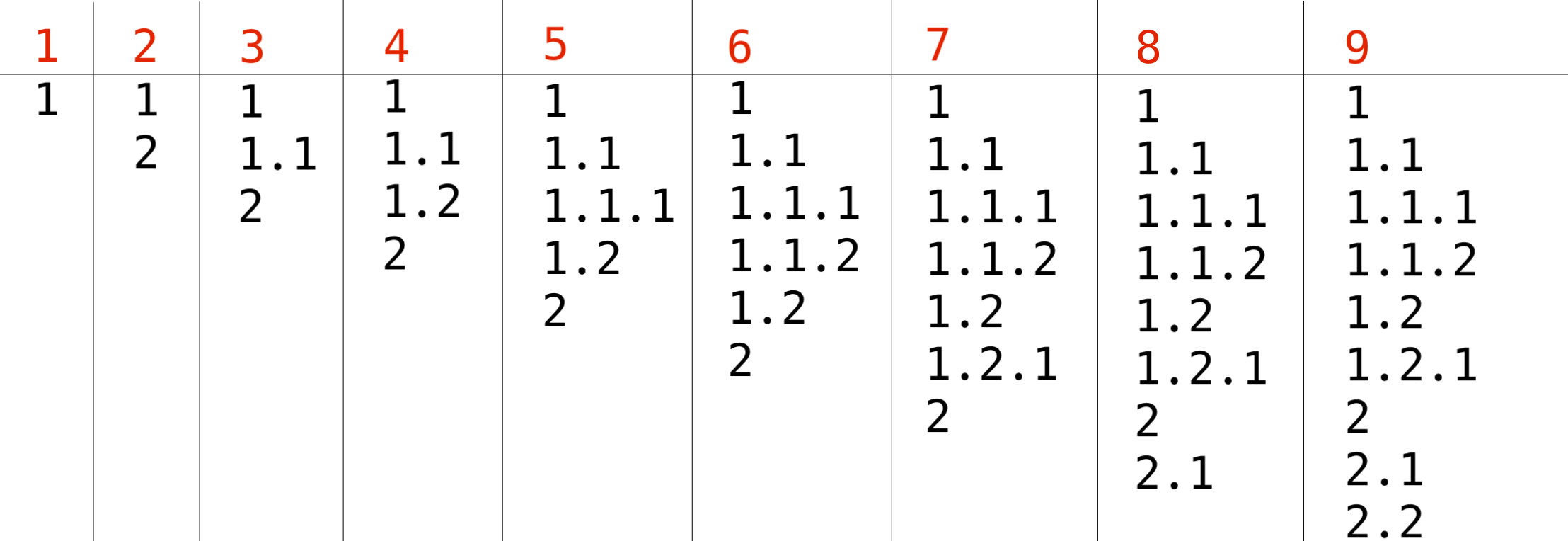
William is a huge fan of planning ahead. That is why he starts his morning routine by creating a nested list of upcoming errands.
A valid nested list is any list which can be created from a list with one item "1" by applying some operations. Each operation inserts a new item into the list, on a new line, just after one of existing items $$$a_1 \,.\, a_2 \,.\, a_3 \,.\, \,\cdots\, \,.\,a_k$$$ and can be one of two types:
- Add an item $$$a_1 \,.\, a_2 \,.\, a_3 \,.\, \cdots \,.\, a_k \,.\, 1$$$ (starting a list of a deeper level), or
- Add an item $$$a_1 \,.\, a_2 \,.\, a_3 \,.\, \cdots \,.\, (a_k + 1)$$$ (continuing the current level).
When William decided to save a Word document with the list of his errands he accidentally hit a completely different keyboard shortcut from the "Ctrl-S" he wanted to hit. It's not known exactly what shortcut he pressed but after triggering it all items in the list were replaced by a single number: the last number originally written in the item number.
William wants you to help him restore a fitting original nested list.
Each test contains multiple test cases. The first line contains the number of test cases $$$t$$$ ($$$1 \le t \le 10$$$). Description of the test cases follows.
The first line of each test case contains a single integer $$$n$$$ ($$$1 \le n \le 10^3$$$), which is the number of lines in the list.
Each of the next $$$n$$$ lines contains a single integer $$$a_i$$$ ($$$1 \le a_i \le n$$$), which is what remains of William's nested list.
It is guaranteed that in each test case at least one fitting list exists.
It is guaranteed that the sum of values $$$n$$$ across all test cases does not exceed $$$10^3$$$.
For each test case output $$$n$$$ lines which represent a valid nested list, which could become the data provided to you by William.
If there are multiple answers, print any.
2 4 1 1 2 3 9 1 1 1 2 2 1 2 1 2
1 1.1 1.2 1.3 1 1.1 1.1.1 1.1.2 1.2 1.2.1 2 2.1 2.2
In the second example test case one example of a fitting list is:
1
1.1
1.1.1
1.1.2
1.2
1.2.1
2
2.1
2.2
This list can be produced by using the sequence of operations shown below: 
- Original list with a single item $$$1$$$.
- Insert item $$$2$$$ by using the insertion operation of the second type after item $$$1$$$.
- Insert item $$$1.1$$$ by using the insertion operation of the first type after item $$$1$$$.
- Insert item $$$1.2$$$ by using the insertion operation of the second type after item $$$1.1$$$.
- Insert item $$$1.1.1$$$ by using the insertion operation of the first type after item $$$1.1$$$.
- Insert item $$$1.1.2$$$ by using the insertion operation of the second type after item $$$1.1.1$$$.
- Insert item $$$1.2.1$$$ by using the insertion operation of the first type after item $$$1.2$$$.
- Insert item $$$2.1$$$ by using the insertion operation of the first type after item $$$2$$$.
- Insert item $$$2.2$$$ by using the insertion operation of the second type after item $$$2.1$$$.
| Name |
|---|




